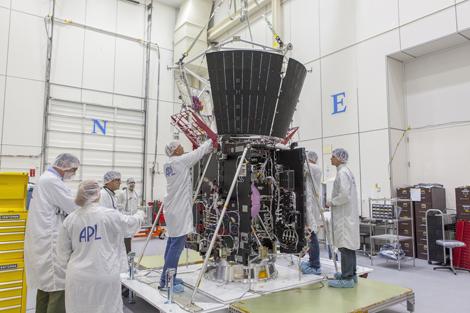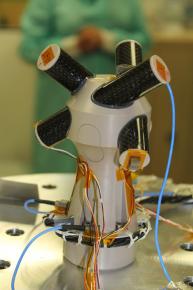Parker Solar Probe: French research takes off towards the Sun
Parker Solar Probe will soon become the closest spacecraft to the Sun, just over 6 million kilometres from the surface of our star. This NASA probe will include an instrument developed by researchers from the CNRS, the University of Orléans and the CNES during its trip in the solar corona. In all, five French laboratories, including IRAP (Université Paul Sabatier Toulouse III and CNRS) are involved in this mission to reveal the phenomena observed in the Sun’s atmosphere. The probe is scheduled to leave Earth on August 11, 2018.

A little closer to the stars, in the plasma corona that surrounds the Sun. This is the objective of NASA’s Parker Solar Probe mission to try to solve one of the greatest mysteries of contemporary physics: how can the temperature of its atmosphere exceed one million degrees when its surface temperature is only 6,000°C? Astrophysicists have already proposed that the corona could be heated by electromagnetic waves produced at the surface, but it is impossible to test this hypothesis without going there, in an environment with extreme conditions, as this probe will do. Its measurements will also make it possible to study other phenomena, such as the genesis of solar winds.
Parker Solar Probe will reach its goal in November 2018, just three months after its launch from Cape Canaveral on August 11 aboard a Delta IV Heavy rocket, NASA’s most powerful launcher. To reach its objective so quickly, the spacecraft will break the speed record relative to the Sun1 : as close as possible to the star, it will reach 700,000 kilometres per hour. At this speed relative to the Earth, Parker Solar Probe would link Paris to Sydney in less than 2 minutes! The probe will make twenty-five passes close to the Sun during this mission, interspersed with passes close to the Earth’s orbit during which the data collected can be sent to scientists. Its last three passes will bring it as close as possible to the Sun, about 6 million kilometres from the solar surface.
This American mission benefits from the expertise of five French laboratories, such as the Laboratoire de physique et chimie de l’environnement et de l’espace (LPC2E; CNRS/CNES/Université d’Orléans), which has developed an instrument on board Parker Solar Probe: its induction magnetometer will measure variations in the magnetic field in the solar corona. These measurements will therefore be crucial for understanding how it can be heated to temperatures in excess of one million degrees.

In addition, teams from the Laboratoire d’études spatiales et d’instrumentation en astrophysique (Observatoire de Paris-PSL/CNRS/Université Paris Diderot/Sorbonne University) and the Plasma Physics Laboratory (CNRS/Observatoire de Paris-PSL/Ecole polytechnique/Université Paris-Sud/Sorbonne University) participated in the development of a radio receiver and two spectrometers, manufactured in the United States. As for the Institut de recherche en astrophysique et planétologie (CNRS/CNES/Université Toulouse III-Paul Sabatier), it will be involved in the exploitation of the images from the camera carried by the probe. Finally, the solar furnace of the CNRS Processes, Materials and Solar Energy Laboratory has made it possible to test the materials and sensors of Parker Solar Probe in conditions close to those they will encounter around the Sun.
The know-how of these laboratories will also benefit another solar exploration mission in 2020: in turn, the European Space Agency’s Solar Orbiter mission will take to the Sun with various measuring instruments developed in several French laboratories on board.
Note
1 To express space velocities unequivocally, they are defined in relation to the object exerting the strongest gravitational influence. The previous speed record in relation to the Sun was set in 1976 by the Helios B mission with a speed of 252 782 km/h.
IRAP Contact
- Philippe Louarn, philippe.louarn@irap.omp.eu






